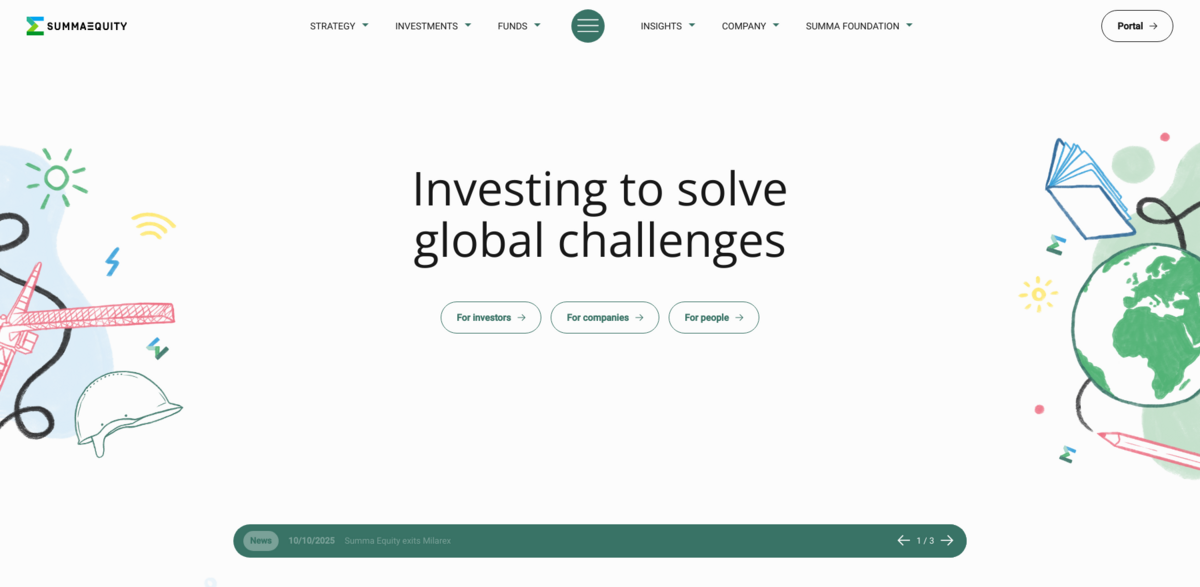What Summa’s Investment Strategy Is All About
Summa is on a mission to invest in change — real, lasting change that tackles global challenges while driving profitable transitions. Their strategy? Focus on areas that thrive even when uncertainty hits, steering clear of the green boom-and-bust rollercoaster. They zero in on sectors where the green transition makes economic sense and is financially rewarding. This means doubling down on strengths in Circularity, Sustainable Food, Energy Transition, and Tech-Enabled Resilience — areas where they have deep expertise and a proven track record. It’s about smart, sustainable investing that delivers solid financial results while pushing the world toward a better future.
Main Benefits and Key Figures
Summa’s approach isn’t just talk — the numbers back it up. Here are some highlights that show the impact and scale of their portfolio:
- 1,498,831 TCO2: Potentially avoided emissions, a huge win for the planet
- 11 out of 19: Companies moving toward or already validated by Science Based Targets
- 10,978: Employees working across portfolio companies, driving change every day
- 31%: Female diversity across the portfolio, showing commitment to inclusion
- 92%: Compliance with Summa’s policy implementation, ensuring consistency
- 100%: Portfolio companies reporting according to SFDR PAI standards
From Vision to Value: The Infobric Story
Take Infobric, for example — a construction software company focused on protecting workers and assets. Summa invested back in February 2019, spotting its huge potential early on. Infobric’s revenues hit SEK 182 million in 2019, but that was just the beginning. The company has been evolving rapidly: shifting to a hardware-enabled software model with 78% recurring revenues, expanding internationally (hello, UK in 2021!), and growing its team from 73 to 310 full-time employees. Plus, they’ve been busy strengthening their organizational platform with key hires. It’s a textbook case of turning vision into real value.
Intentionality: The Heart of Summa’s Impact Approach
Summa’s impact isn’t accidental — it’s intentional. They believe you can’t manage what you can’t measure, and you can’t imagine what you don’t understand. To change a system, you’ve got to picture a new version of it. That’s why Summa focuses on the bigger picture, looking at the systems behind issues like climate change, biodiversity loss, and inequality. Tackling these problems in isolation? Not their style. Instead, they reimagine systems in innovative ways, avoiding unintended consequences and unlocking real investment potential. Companies that solve problems holistically are the future winners — delivering both financial returns and positive societal impact. It’s a win-win that aligns perfectly with Summa’s mission.
The Theory of Change Framework: Mapping the Path to Impact
Summa uses a rigorous theory of change framework to guide their investments. This framework helps them identify future winners by structuring their thinking around the vision for change, the path to get there, and the assumptions needed along the way. It’s a blend of imagination and measurement — spotting indicators of progress, success, or failure. The framework also creates transparency, showing the causal links between inputs, activities, and the desired impact. By understanding how portfolio companies’ outputs connect to broader outcomes, Summa can visualize how each investment fits into the bigger vision and what else needs to happen for impact to fully materialize.
Project Impact: Linking to the Sustainable Development Goals (SDGs)
- SDG 7: Affordable and Clean Energy
- SDG 9: Industry, Innovation, and Infrastructure
- SDG 12: Responsible Consumption and Production
- SDG 13: Climate Action
- SDG 15: Life on Land
- SDG 17: Partnerships for the Goals
Why Summa’s Approach Matters in Private Equity
In the world of private equity, where the pressure to deliver financial returns is intense, Summa stands out by integrating ESG and SDG considerations deeply into their investment process. They don’t just chase profits; they invest with purpose. This means avoiding the hype cycles that can derail green investments and instead focusing on sustainable, resilient businesses that can weather uncertainty. Their portfolio companies aren’t just ticking boxes — they’re actively contributing to a sustainable future while delivering strong financial performance. It’s a fresh take on private equity that proves responsible investing and profitability can go hand in hand.





















